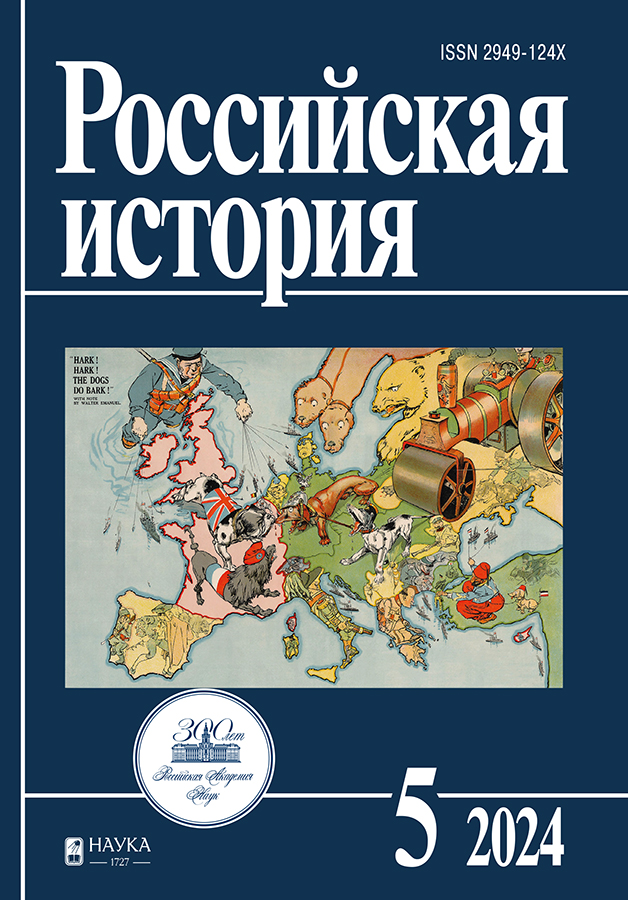Formation of the public image of the KGB in 1954–1991
- 作者: Guseva J.N.1, Khristoforov V.S.2
-
隶属关系:
- Moscow City University
- Institute of Russian History, Russian Academy of Sciences
- 期: 编号 5 (2024)
- 页面: 163-173
- 栏目: Institutions and communities
- URL: https://ter-arkhiv.ru/2949-124X/article/view/663225
- DOI: https://doi.org/10.31857/S2949124X24050105
- EDN: https://elibrary.ru/SKRUKS
- ID: 663225
如何引用文章
详细
The article analyzes the main trends in the presentation of the activities of the domestic security services in the public space in 1950s - 1991. The authors analyze the main content of the media discourse that accompanied the activities of the USSR KGB. This discourse of representations about its own past, traditions and innovations in its work and special corporate ethics. Using discourse analysis, the authors examine the PR-strategies of the Soviet state security agencies as an expression of the changes in the state policy towards the special services and the evolution of their own, departmental, narrative about the past and present. The authors analyze the dynamics of this process: from the first attempts at “self-purification” of the Khrushchev era of the 1950s to the adherence to the ideals of the perestroika era of the late 1980s and early 1990s. As a result, a conclusion is drawn about the potential influence of the KGB's media discourse about itself and its past on the mechanisms of interaction between the state security agencies and Russian society and the formation of the public image of the security services as a whole.
全文:
作者简介
Julia Guseva
Moscow City University
编辑信件的主要联系方式.
Email: otech_ist@mail.ru
доктор исторических наук, профессор
俄罗斯联邦, MoscowVasiliy Khristoforov
Institute of Russian History, Russian Academy of Sciences
Email: otech_ist@mail.ru
доктор юридических наук, член-корреспондент РАН, главный научный сотрудник
俄罗斯联邦, Moscow参考
- Авилова Н.Л., Шуров А.И. Актуальные вопросы историографии органов КГБ СССР // Известия Курского государственного технического университета. 2010. № 3(32). С.121–127.
- Викторов Д., Львов О. Не только Штирлиц. Контрразведка в советском кинематографе. М.: Вече, 2022. 464 с.
- Зданович А. Введение // Команда Андропова. [сб. воспоминаний и арх. материалов / О-во изучения истории отечеств. спецслужб; сост., подбор арх. док. и фот.: В. К. Былинин]. М.: Русь, 2005. 254 с. С.9–15.
- Крыштановская О.В. Опыт проведения социологических исследований Службы государственной безопасности // КГБ: вчера, сегодня, завтра. Сборник докладов. М.: Знак-СП, Гендальф, 1993. С. 123–134.
- Малинова О.Ю. Политика памяти как область символической политики // Методологические вопросы изучения политики памяти / отв. ред. Миллер А.И., Ефременко Д. В. М.-СПб: Нестор-История, 2018. С. 27–53.
- Малинова О.Ю. Кто и как формирует официальный исторический нарратив? (Анализ российских практик) // Полития. 2019. №3(94). С.103–126.
- Петров Н.В. Время Андропова. М.: АФК «Система»; Политическая энциклопедия, 2023. 768 с.
- Петров Н.В. Свои люди в органах государственной безопасности // Режимные люди в СССР / [отв. ред. : Т. С. Кондратьева, А. К. Соколов]. М.: РОССПЭН: Фонд первого президента России Б. Н. Ельцина, 2009. С.303 – 325.
- Пожаров А. И. Противоречия и споры в историографии деятельности советских органов госбезопасности в период 1953–1964 гг. // Диалог со временем. 2010. Вып. 32. С. 279–307.
- Пожаров А.И. Современная источниковая база по истории советских спецслужб 1950-1960-х гг. // Отечественные архивы. 2009. №.5. С. 29–36.
- Федор Дж. Традиции чекистов от Ленина до Путина. СПб.: Питер, 2012. 304 с.
- Хлобустов О.М. Некоторые вопросы историографии КГБ СССР (конец 80-х гг. - 2006 г.) // Труды Общества изучения истории отечественных спецслужб. 2007. Т. 3. С. 64–92.
- Хлобустов О.М. Общественное мнение населения об органах государственной безопасности (конец 1980-х - 1990-е гг.) // Деятельность отечественных спецслужб в эпоху социальных катаклизмов: материалы Междунар. науч.-практ. конф. (Омск, 23 нояб. 2017 г.). Омск: Изд-во ОмГТУ, 2017. 256 с. [Электронный ресурс]. Режим доступа: http://rummuseum.info/node/5807 (дата обращения – 01.10.2024).
- Eugene Huskey (1990) Government Rulemaking as a Brake on Perestroika, in Law and Social Inquiry, рр.419-424.
- Jens E. (2017) Cold War Spy Fiction in Russian Popular Culture: From Suspicion to Acceptance via Seventeen Moments of Spring, in Studies in Intelligence, Vol 61: 2, pp.31–35.
- Knight A. (2000) The Selling of the KGB, in The Wilson Quarterly, Vol. 24, № 1, рр. 16–23.
- Pringle Robert W. (2000) Andropov's Counterintelligence State, in International Journal of Intelligence and CounterIntelligence, Vol.13: 2, рр. 193–203, doi: 10.1080/08850600050129718
- Sanshiro Hosaka (2023) The KGB and Glasnost: A Contradiction in Terms? in Demokratizatsiya: The Journal of Post-Soviet Democratization, Vol. 31: 1, рр. 57–90.
- Simon Miles (2021) The Problems of Perestroika: The KGB and Mikhail Gorbachev’s Reforms, in Slavic Review, Vol. 80, №. 4, рр. 816–838.
- Shebarshin L. (1993) Reflections on the KGB in Russiа // Economic and Political Weekly, Vol. 28, № 51, рр. 2829–2832.
- Stephen White and Ol'ga Kryshtanovskaya (1993) Public Attitudes to the KGB: A Research Note, in Europe-Asia Studies. Vol. 45, №. 1, pp. 169–175.
补充文件









